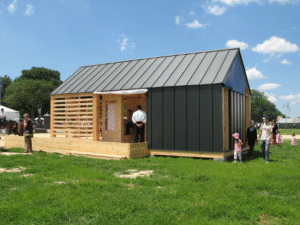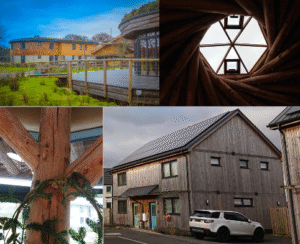Seeing the wood and the trees: the role of timber in future Wales – Calvin Jones
“And he could see a tall tree on the river bank, and the one side of it was burning from its roots to its tip, and the other half with green leaves…”
Peredur son of Efrawg
(Jones and Jones, 1989, p. 211)
Wales, along with the rest of the UK desperately lacks trees. Between the first, pre-Christian telling of the tales of the Mabinogion and the writing of William’s Domesday book in 1086 tree cover had fallen from perhaps as much as half the landscape to only 15%. There it remains to this day.
Trees, however scarce, are important. The vision faced by Peredur of a tree half in flames and half full of life could hardly be more apposite for a nature and people challenged by runaway climate change, and at the same time desperately dependent on nature to help respond to that challenge. Not just to provide energy, materials and wellbeing, but to show how the rhythmic circularity of the natural world can help us move to properly sustainable economies. And because of the wholesale deforestation of the UK, we are – especially in Wales – left with a particular sort of tree. In Wales, almost half of our trees are conifers; non-native (almost half of them Sitka Spruce), planted mostly in large blocks and for (originally) reasons of commerce and national security. Over time, the core rationale for planting and management has been softened and widened to recognise that firstly, nature and people require more than monocultures to thrive, and secondly, that former approaches to land management make little sense when productivity is increasingly vulnerable to the new diseases, pests, storm damage and wildfires that are inevitable consequences of a changed climate.
Public land managers in Wales – largely in Natural Resources Wales – are thus moving to more holistic approaches and greater species diversity under their legally mandated requirement for the Sustainable Management of Natural Resources (SMNR). At the same time, the devolved Welsh Government recognises the potential for wood products to contribute across a number of important policy objectives. The greater and wider use of Welsh wood can help in its desire for more foundational, locally impactful, low carbon and circular regional economies. As such, the Government wants to see more wood come to market. There are, however a number of issues and barriers facing the region as it seeks to drive higher economic value from its woodland, whilst protecting and enhancing natures’ functioning, and reducing emissions and sequestering carbon.
In June 2009 I was at the Smithsonian Folklife exhibition as the National Mall in Washington D.C. was given over to a celebration of everything Wales and Welsh. Part of that exhibition was the Ty Unnos – house of one night. The name references an old Welsh tradition that if one could build a house in a single night on common land, and by morning the roof was rainproof, the builder would own that house and the land it sat upon. In 2009 the Ty Unnos was a showcase of what Welsh wood could do if used in construction – taking ‘low value’ Welsh Sitka and Douglas Fir and via the use of modular construction and box and ladder beams make it fit for structural construction uses – with all IP open-sourced.

Fifteen years later, the Ty Unnos project amounts to some great ideas and dozen or so exemplar projects, but little else. This speaks to the difficulty of moving the dial on house – and non-domestic – construction, even in a polity which has autonomy over relevant competencies and regulations, and where circularity, low-carbon and sustainability are written deep in law. Many of the issues that led to the non-progression of Ty Unnos still exist, stymying efforts to widen the uses of Welsh wood.
Reputation & Culture – Recent attempts by Government and others to persuade the housing associations that provide much (formerly public) social housing to build with Welsh wood – or wood at all – have met with some success but also much difficulty, In part this is to do with the reputation of Welsh (soft) wood as of low quality, especially vis-a-vis slower growing Baltic sawn softwood. Added to this is the novelty of building with Welsh wood – involving not just different products, but also different suppliers and relationships. Many Welsh housing associations mostly manage housing stock transferred from local/municipal authorities, with development and construction a smaller (but growing) part of their activities. Novel construction – modular, off-site, self-organised, local – may well be a step too far given the historical context of a housing market dominated by a small number of very large UK firms constructing a limited suite of block-built homes.
Cost – Building to scale, with established techniques and standard, tested materials is of course cheap – at least for the builder, the developer and the initial purchaser (whether social or private). It is, of course only cheap from that perspective. The mineral materials used to build – bricks, blocks, gypsum, cement – have very significant costs in terms of climate emissions that are not fully captured in their prices. Meanwhile, whilst new houses can perform well on standardised measures of energy efficiency, they rarely in the UK have microgeneration or heat pumps locked in at construction, leaving owners to retrofit in the later on at far greater cost – and with implications for owners’ and tenants’ energy costs across the long term. Devising a system that reduces the lifetime costs of new housing – financial, energy or climate – has had little attention, meaning more long term-sustainable methods are disadvantaged.
Data – Wales lacks public and widely accepted data, not only on the lifecycle performance of different house archetypes, but also on the uses of its timber, relying on UK Forestry Research to model the likely uses to which Welsh wood is put. This means that there is uncertainty as to the ultimate financial value of Welsh wood, or indeed for how long carbon is locked up before the wood is burned, or abandonment and decomposition of wood products let the atmosphere take the strain once again. It is difficult to direct timber to higher value uses in this data-poor environment, environmental or financial, especially when for foresters (private or public) their job has traditionally finished as the logs are taken out of the coup.
Traceability – Relatedly, whilst there is reasonable data on the volume and type of wood harvested in Wales, once it leaves the woodland for the sawmill – sometimes within Wales, sometimes outside – the trail is lost. British woodland is managed to a very high standard of sustainability, but the ‘Britishness’ is all that can be identified. If, then, any customer does wish to source Welsh wood for a project for reasons of local economic impact, community development, marketing or sheer hwyl, the onus is on that customer to source the very trees, buy them and manage their processing into the products required. Guaranteed Caerphilly cheese? Doable. Ceredigion wood? Not so much.
The complexity of multi-functionality – Wales has historically been a land of monocultures – sheep, cattle, conifers – with each managed for narrow, commercial returns. The 21st century is a time of multifunctionality – of optimising land management across different outcomes and objectives; for the climate, biodiversity, flood remediation, recreation, and renewables for example. A multi-objective approach makes huge demands on both land managers and upon the policies, regulations and laws that guide them. These demands are on data, political capital, and sheer headspace. Devolved government meanwhile is young (just turned 25), data poor and lacking in capacity. It is perhaps unsurprising that, despite some progress, there has been a lack of a dedicated and thoroughgoing approach to building high-value and circular markets and supply chains for wood products, especially when there are more urgent and politically acute rural problems.
It is not, however, all gloom. Firstly, a number of organisations have been diligently and carefully pushing the boundaries of what is possible with wood in construction, even under current commercial and regulatory conditions. For example, Down to Earth, a social enterprise in south-west Wales, has been delivering training, outdoor schooling, venue hire and more using its own-built wood-framed and wood-roofed buildings, where larch and fir are used in engineered, plank and round-wood forms. The organisation has also built a number of wood-framed houses for social tenants, and assessed the feasibility of constructing wood-framed sustainable schools. It is in the process of developing a manufacturing plant to enable communities to create home-grown wood panelling for housing and civic infrastructure.

Meanwhile, the Government in Wales and a coalition of social landlords have recognised that progress can be made in making social housing both better and cheaper. In early 2025 the Tai ar a Cyd (shared housing) scheme launched a standard pattern book with fifteen houses (and more variants) designed to be affordable, low-carbon, comfortable, home-grown and durable. If the use of the pattern book becomes widespread, it will unlock the development of new partnerships, skills, and supply chains, finding close-to-home and sustainable uses for Welsh and UK wood. The forthcoming Welsh Government Timber Industrial Strategy, currently will envisage much more of this.
Timber in Wales then is in liminal space in terms of its value and uses. It is widely recognised as an important, reliable, low-carbon and sustainable resource, certainly relative to many of its substitutes. It is gaining increasing attention and visibility in a range of construction uses, and fits well with a more general orientation in Wales to more circular, foundational and locally-value-adding economic approaches. Yet significant barriers remain around reputation, cost (of both timber and its products), ignorance and inertia. To steward and grow the green half of the tree, whilst dousing the burning half, will take dedicated, thoughtful and prolonged effort. Just like the in trials of Peredur, son of Efrawg.
Calvin is a Professor at Cardiff Business School, Managing Director at Jones the Numbers and a partner investigator of the Australian Research Council Research Hub to Advance Timber for Australia’s Future built Environment (ARC Advance Timber Hub) located at The University of Queensland.
View all resources